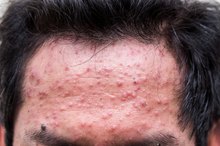What does fact checked mean?
At Healthfully, we strive to deliver objective content that is accurate and up-to-date. Our team periodically reviews articles in order to ensure content quality. The sources cited below consist of evidence from peer-reviewed journals, prominent medical organizations, academic associations, and government data.
The information contained on this site is for informational purposes only, and should not be used as a substitute for the advice of a professional health care provider. Please check with the appropriate physician regarding health questions and concerns. Although we strive to deliver accurate and up-to-date information, no guarantee to that effect is made.
Types of Bacteria Found in Makeup
If you've accumulated makeup over the years, and never seem to throw any away, it may be time for an out with the old, in with the new moment. One of the reasons is that old makeup--especially previously used makeup--is associated as a breeding ground for bacteria that can cause minor to serious skin and eye infections. Although many forms of makeup contain preservatives that work to slow bacteria growth, it is still possible to experience a bacterial infection from old makeup. If makeup is discolored, strange-smelling or older than one year, you should discard it.
If you are experiencing serious medical symptoms, seek emergency treatment immediately.
Staphylococcus Epidermidis
Staphylococcus epidermidis is a form of staph bacteria that has been found on lipsticks, eyeshadows and eyeliners during laboratory testing. While this bacteria often is found naturally on human skin, for those with a compromised immune system--due to a severe illness, old age or a chronic illness--may develop an infection. Some strains of this bacteria are resistant to antibiotic treatment and can severely affect the intestines if left untreated.
- Staphylococcus epidermidis is a form of staph bacteria that has been found on lipsticks, eyeshadows and eyeliners during laboratory testing.
- Some strains of this bacteria are resistant to antibiotic treatment and can severely affect the intestines if left untreated.
Staphylococcus Warneri
What Is the Difference Between Cellulitis & Mrsa?
Learn More
Another member of the staphylococcus bacteria group, Staphylococcus warneri also is found on the skin of humans and animals. While it may not cause adverse reactions in those with healthy immune systems, it can cause severe reactions and illness in those with compromised immune systems. In the most extreme cases, this bacteria is associated with endocarditis, which is damage to the heart valves.
Pseudomonas Aeruginosa
Pseudomonas aeruginosa is a common bacteria found in soil, water and on the skin and has been associated with inflammation, rash and in severe cases, sepsis--a serious infection that can cause organ failure. Pseudomonas aeruginosa that live on a mascara wand that can nick the eye or penetrate into the soft tissues or membranes of the eye.
Methicillin-Resistant Staphylococcus Aureus
What Is the Difference Between Cellulitis & Mrsa?
Learn More
This bacteria is considered very dangerous because the infection can be easily spread 1. When applying makeup, MRSA present in the makeup can enter a pimple, open cut or the mucous membranes of the eye and nose. Initial signs of infection including redness, inflammation and heat over the infected area. If you suspect you may be infected with MRSA, seek immediate treatment.
- This bacteria is considered very dangerous because the infection can be easily spread 1.
- Initial signs of infection including redness, inflammation and heat over the infected area.
Related Articles
References
Writer Bio
Rachel Nall began writing in 2003. She is a former managing editor for custom health publications, including physician journals. She has written for The Associated Press and "Jezebel," "Charleston," "Chatter" and "Reach" magazines. Nall is currently pursuing her Bachelor of Science in Nursing at the University of Tennessee.








